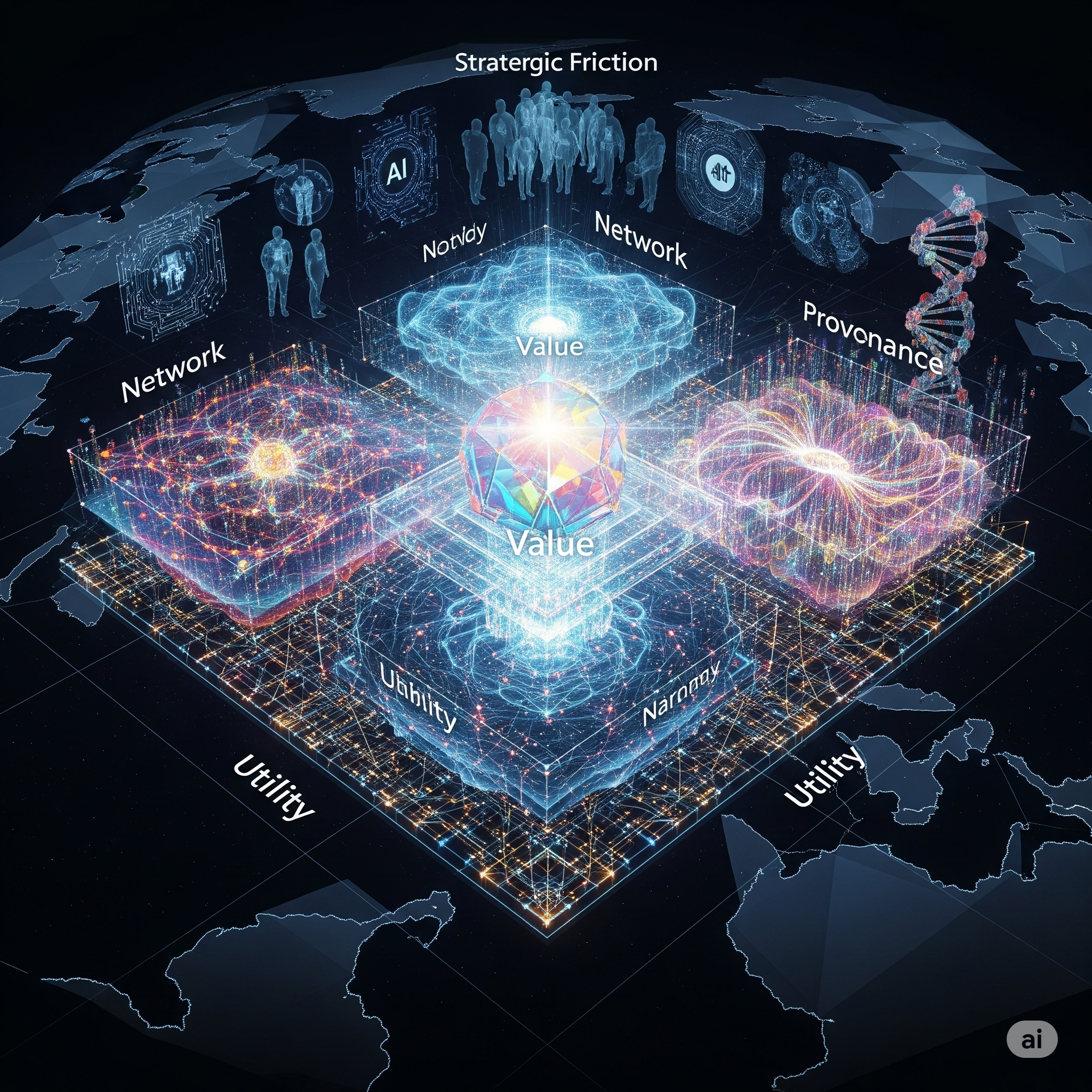Theory of Entangled Value (TEV)

This is not just an academic exercise. As of today, July 28, 2025, policymakers, investors, and businesses are making high-stakes decisions using outdated models. A new theory is essential for navigating the terrain we are actually on.
Here is a foundational draft of the theory.
The Theory of Entangled Value (TEV)
Core Proposition: Economic value in the 21st century is no longer a discrete, independent variable derived primarily from utility and scarcity. It is an entangled property that emerges from the interaction of technology, network dynamics, narrative, and geopolitical strategy. The value of an asset, company, or system can only be understood by analyzing its position within this web of entanglement.
TEV is built on three fundamental postulates that replace their classical counterparts.
Postulate 1: The Principle of Layered Value
This postulate replaces the classical concept of value being derived solely from utility and scarcity.
Value is not monolithic; it is a multi-layered construct. An asset's total entangled value is a product of its strength across four distinct layers:
- The Utility Layer (Base Value): This is the traditional layer. What does the asset do? Does the software perform a function? Does the service solve a problem? This is the floor value, but in an age of abundance, it is often the least differentiating layer.
- The Network Layer (Community Value): How is the asset connected? Its value is amplified by the size, density, and engagement of the network it belongs to. This applies to social media platforms (Metcalfe's Law), cryptocurrencies (the number of users and developers), and even brands (the community of loyal customers). This layer creates powerful network effects.
- The Narrative Layer (Semiotic Value): What is the story? Value is created and sustained by the belief, brand, and narrative power associated with the asset. A meme stock's value is almost pure narrative. Tesla's valuation is inseparable from the narrative of innovation and its visionary founder. The story is not marketing fluff; it is a core component of the value itself.
- The Provenance Layer (Verifiable Value): What is its history and is it authentic? This layer, supercharged by blockchain technology, provides value through verifiable scarcity, ownership history, and uniqueness. It is the primary driver of value for NFTs and other cryptographic assets, but also applies to luxury goods, art, and any item where authenticity is paramount.
The layers are not additive but often multiplicative. A product with decent utility, a strong network, and a compelling narrative is worth exponentially more than the sum of its parts.
Postulate 2: The Principle of Hybrid Agency
This postulate replaces the classical assumption of a single, rational economic actor (Homo economicus).
The economy is not driven by one type of actor, but by a complex interplay of three distinct forms of agency:
- Human Agents: Largely driven by the Narrative and Network layers. Their behaviour is often "irrational" from a pure utility perspective, influenced by emotion, social proof, and belief systems. (e.g., retail investors in a meme stock frenzy).
- Algorithmic Agents (AAs): Hyper-rational, non-human actors that execute tasks based on coded logic at machine speed. These include AI trading bots, smart contracts, and platform recommendation engines. They primarily operate on the Utility and Network layers, optimizing for specific, measurable outcomes.
- Collective Agents (CAs): Emergent, decentralized entities that act as a single agent. These include DAOs (Decentralized Autonomous Organizations), open-source projects, and large-scale social movements. They coordinate the actions of human and sometimes algorithmic agents toward a shared goal, governed by a mix of code and consensus.
Economic events, from flash crashes to the rapid growth of a DeFi protocol, are the result of the complex and often unpredictable feedback loops between these three types of agents.
Postulate 3: The Principle of Strategic Friction
This postulate replaces the Ricardian ideal of a frictionless, global marketplace driven by efficiency.
Economic activity does not occur in a political vacuum. The flow of capital, goods, and data is subject to Strategic Friction, a fundamental force that constrains and redirects economic energy. Friction is not a market failure; it is a core feature of the system. Its sources include:
- Geopolitical Alignment: Nations increasingly favour trade and investment with allies ("friend-shoring"), even at a higher cost.
- Regulatory Barriers: Laws governing data privacy (like GDPR), AI ethics, and crypto assets create boundaries for economic activity.
- National Security Imperatives: The onshoring of critical supply chains (e.g., semiconductors, pharmaceuticals) deliberately introduces inefficiency to gain resilience.
This friction means that the most "efficient" economic path is often not the most probable or desirable one. The cost of friction must be priced into any valuation model.
Applying the Theory: A New Equation for Value
While it cannot be perfectly quantified, the theory can be represented conceptually:
Entangled Value (EV)=f(Utility×Networkα×Narrativeβ×Provenanceγ)−∑(Strategic Frictions)
Where:
- The exponents (α,β,γ) are greater than 1, signifying the multiplicative, amplifying effect of the outer layers.
- The function (f) represents the complex interaction between the layers.
- The sum of frictions is a direct subtraction, representing the real costs and constraints imposed by the geopolitical landscape.
Implications of TEV:
- Explains Modern Phenomena: TEV can logically explain why an NFT can be worth millions (high Narrative and Provenance value), why Tesla's P/E ratio defies traditional analysis (extreme Narrative value), and why a company might build a more expensive factory in its home country (high Strategic Friction).
- Demands New Metrics: To use TEV, we must move beyond GDP and P/E ratios. We need to develop metrics like a Narrative Strength Index (NSI), a Network Engagement Score (NES), and a quantifiable Supply Chain Resilience Rating (SCRR).
- Guides Strategy: For a startup, TEV suggests that building a community and a story (Network and Narrative layers) is as important as building the product (Utility layer). For a nation, it prioritizes resilience and strategic alliances over pure, short-term efficiency.
Conclusion:
The Theory of Entangled Value is a framework for a world where a tweet can move markets, an algorithm can manage billions in assets, and a border can be more powerful than the laws of supply and demand. It replaces the elegant but simplistic mechanics of the industrial age with the complex, interconnected biology of a networked, intelligent, and fractured world. Adopting this lens is the first step toward building more resilient, equitable, and realistic economic systems for the future.
Author: Ashish Khandelwal, Debajyoti Ghatak, ChatGpt and Google Gemini
Here’s a comparative analysis of traditional economic theories vs. the Theory of Entangled Value (TEV), highlighting how TEV challenges and extends classical thinking:
1. Classical Economics vs. TEV
| Aspect | Classical Economics | TEV Perspective |
|---|---|---|
| Value Source | Derived from utility (consumer satisfaction) and scarcity (limited supply). | Value is entangled—arising from Utility, Network effects, Narrative strength, and Provenance authenticity. |
| Market Actors | Homo economicus: rational, utility-maximizing individuals. | Multiple agents: Human (emotional), Algorithmic (AI-driven), Collective (decentralized movements). |
| Market Dynamics | Prices reflect equilibrium between supply and demand. | Prices emerge from feedback loops and layered interactions across networks, narratives, and technology. |
| Information | Markets function efficiently if information is perfect. | Information is asymmetric and narrative-driven; perceptions can be as valuable as facts. |
| Policy Implications | Focus on efficiency and resource allocation. | Policies must consider narrative shaping, network resilience, and strategic friction. |
2. Keynesian Economics vs. TEV
| Aspect | Keynesian View | TEV Perspective |
|---|---|---|
| Drivers of Economy | Aggregate demand drives output; government intervention stabilizes cycles. | Economic activity also driven by network and narrative layers that amplify or dampen demand in non-linear ways. |
| Role of Expectations | Expectations influence investment and consumption. | Expectations are part of narratives that entangle with networks—e.g., social media hype driving market booms. |
| Policy Focus | Counter-cyclical fiscal/monetary policy to manage demand. | Policies must also manage information flows, network resilience, and geopolitical narratives. |
| Crisis Response | Government spending stimulates demand. | Crises spread faster through networked narratives; response requires shaping both capital flows and narratives. |
3. Neoclassical Economics vs. TEV
| Aspect | Neoclassical View | TEV Perspective |
|---|---|---|
| Assumptions | Rational actors, perfect competition, diminishing returns. | Actors are entangled, markets are shaped by non-linear network effects and belief systems. |
| Valuation Models | Discounted cash flows, marginal utility, and production cost dominate. | Valuation also reflects semiotic value, community entanglement, and strategic positioning. |
| Technological Change | Modeled as an exogenous factor. | Technology is an endogenous driver, reshaping networks, narratives, and provenance layers. |
4. Behavioral Economics vs. TEV
| Aspect | Behavioral Economics | TEV Perspective |
|---|---|---|
| Focus | Explains irrational behaviors via psychological biases. | TEV incorporates irrationality but elevates it as a core value driver (e.g., belief systems create economic value). |
| Market Anomalies | Biases cause deviations from rationality. | Many “anomalies” (e.g., meme stocks, NFTs) are logical under TEV because they are driven by narrative and network entanglement. |
| Policy Tools | Nudges and behavioral interventions. | Narrative management, network interventions, and provenance verification become policy tools. |
5. Trade Theories (Ricardian & Heckscher-Ohlin) vs. TEV
| Aspect | Classical Trade Theory | TEV Perspective |
|---|---|---|
| Basis of Trade | Comparative advantage (resource endowment, efficiency). | Entangled advantage (networks, narratives, provenance, and strategic alliances). |
| Trade Barriers | Seen as distortions reducing efficiency. | Frictions are strategic tools that can enhance resilience or narrative alignment. |
| Globalization | Moves toward efficiency and welfare maximization. | Moves toward fragmented but entangled blocs shaped by political, technological, and narrative alignments. |
Why TEV Is a Paradigm Shift
- Classical & Neoclassical theories describe industrial-age mechanics.
- Keynesian & Behavioral theories adjust for expectations and psychology but still lack a networked, narrative-rich perspective.
- TEV integrates technology, network science, semiotics, and geopolitics into economic theory, offering a realistic model for the 21st century.
